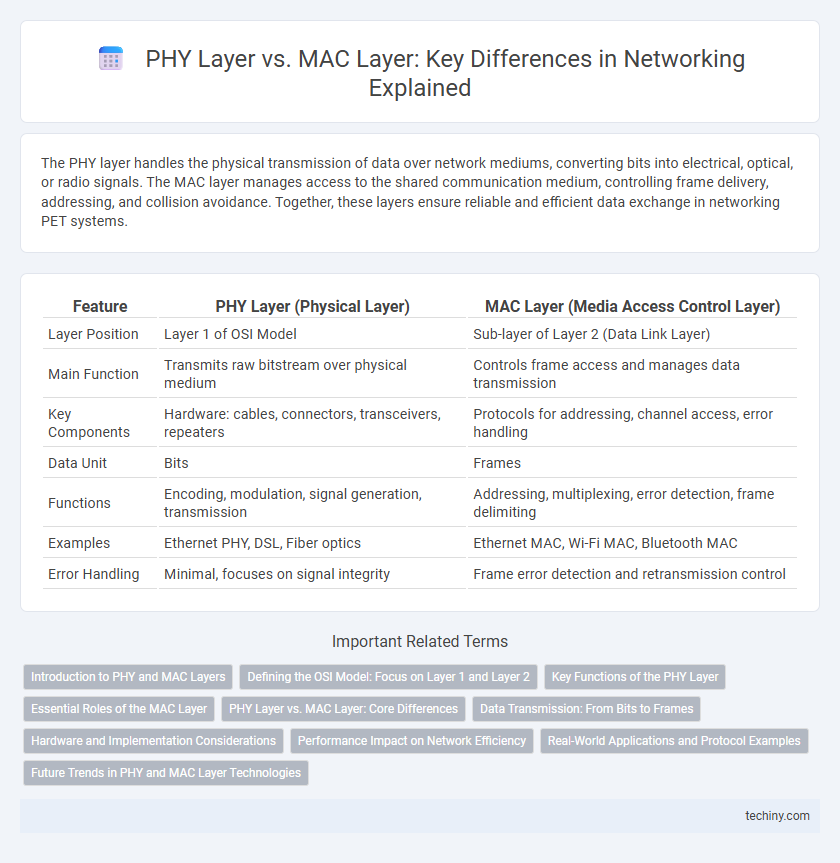The PHY layer handles the physical transmission of data over network mediums, converting bits into electrical, optical, or radio signals. The MAC layer manages access to the shared communication medium, controlling frame delivery, addressing, and collision avoidance. Together, these layers ensure reliable and efficient data exchange in networking PET systems.
Table of Comparison
| Feature | PHY Layer (Physical Layer) | MAC Layer (Media Access Control Layer) |
|---|---|---|
| Layer Position | Layer 1 of OSI Model | Sub-layer of Layer 2 (Data Link Layer) |
| Main Function | Transmits raw bitstream over physical medium | Controls frame access and manages data transmission |
| Key Components | Hardware: cables, connectors, transceivers, repeaters | Protocols for addressing, channel access, error handling |
| Data Unit | Bits | Frames |
| Functions | Encoding, modulation, signal generation, transmission | Addressing, multiplexing, error detection, frame delimiting |
| Examples | Ethernet PHY, DSL, Fiber optics | Ethernet MAC, Wi-Fi MAC, Bluetooth MAC |
| Error Handling | Minimal, focuses on signal integrity | Frame error detection and retransmission control |
Introduction to PHY and MAC Layers
The PHY layer, or Physical Layer, manages the transmission and reception of raw bitstreams over a physical medium such as copper wires, fiber optics, or wireless channels, ensuring signal encoding, modulation, and hardware interfacing. The MAC layer, or Medium Access Control Layer, controls how devices on a network uniquely access the shared communication medium by managing frame encapsulation, addressing, and collision detection or avoidance. Together, the PHY and MAC layers form the foundation of the data link layer in the OSI model, enabling reliable and efficient data transfer between network nodes.
Defining the OSI Model: Focus on Layer 1 and Layer 2
Layer 1, known as the Physical (PHY) Layer, defines the hardware means of transmitting raw bits over a physical medium, including cables, connectors, and signal encoding methods. Layer 2, the Media Access Control (MAC) sublayer of the Data Link Layer, manages protocol access to the physical network medium and handles addressing and error detection for frames. These two layers work together to ensure reliable data transfer from physical signals to structured data frames within the OSI model.
Key Functions of the PHY Layer
The PHY layer is responsible for the physical transmission of data bits over a communication medium, handling signal encoding, modulation, and bit-level synchronization. It manages the conversion of digital data into electrical, optical, or radio signals for transmission and performs error detection at the physical level. Key functions include defining hardware specifications, managing data rates, and ensuring reliable transmission through physical link establishment.
Essential Roles of the MAC Layer
The MAC layer manages access control to the physical transmission medium, preventing collisions and ensuring reliable data delivery within local networks. It assigns unique addresses to devices and regulates frame delimiting, error checking, and retransmissions. By coordinating channel access protocols such as CSMA/CD and CSMA/CA, the MAC layer optimizes bandwidth utilization and enhances network efficiency.
PHY Layer vs. MAC Layer: Core Differences
The PHY layer manages the physical transmission of raw bitstreams over a communication medium, handling signal encoding, modulation, and hardware interfaces like cables and wireless channels. In contrast, the MAC layer controls access to the shared medium, coordinating data frame transmission, error checking, and collision avoidance within the network. Core differences include the PHY layer's focus on electrical and optical signal processing, while the MAC layer prioritizes protocol-driven access control and frame delivery.
Data Transmission: From Bits to Frames
The PHY layer handles the physical transmission of raw bits over a communication channel, converting digital data into signals suitable for the medium such as electrical, optical, or radio waves. The MAC layer organizes these bits into frames, managing access control and error checking to ensure reliable data delivery across the network. Together, the PHY layer provides the foundational bit-level transport, while the MAC layer frames the data with addressing and control information necessary for effective communication.
Hardware and Implementation Considerations
The PHY layer handles the physical transmission of data through hardware components such as transceivers, modulators, and physical connectors, requiring precise analog and digital circuit design to ensure signal integrity and timing accuracy. The MAC layer is implemented primarily in digital logic, often via ASICs or FPGAs, managing frame encapsulation, addressing, error checking, and media access control protocols. Differentiating hardware complexity, the PHY layer demands specialized RF and signal processing techniques, whereas the MAC layer emphasizes protocol logic and timing coordination for efficient data flow.
Performance Impact on Network Efficiency
PHY Layer directly influences network efficiency by determining the raw data transmission rate and signal quality over physical media, affecting error rates and retransmissions. The MAC Layer optimizes performance through frame delimitation, addressing, and collision avoidance, reducing packet loss and enhancing throughput. Effective coordination between PHY and MAC layers minimizes latency and maximizes bandwidth utilization, crucial for high-performance networking.
Real-World Applications and Protocol Examples
The PHY layer handles the physical transmission of data across network media, utilizing standards like Ethernet (IEEE 802.3) and Wi-Fi (IEEE 802.11) for signal modulation and encoding in real-world applications. The MAC layer manages access control and addressing within local networks, exemplified by protocols such as CSMA/CD for Ethernet and CSMA/CA for Wi-Fi, ensuring efficient data frame delivery and collision avoidance. Together, these layers enable reliable and standardized communication across diverse networking environments, from home wireless setups to enterprise LANs.
Future Trends in PHY and MAC Layer Technologies
Future trends in PHY layer technologies emphasize the development of terahertz communication for ultra-high-speed data transfer and the integration of advanced beamforming techniques to enhance signal precision and coverage. In the MAC layer, innovations include AI-driven resource allocation and adaptive MAC protocols that optimize network efficiency and reduce latency in complex IoT ecosystems. Both layers will leverage machine learning algorithms and advanced modulation schemes to meet the demands of 6G networks and beyond.
PHY Layer vs MAC Layer Infographic

 techiny.com
techiny.com